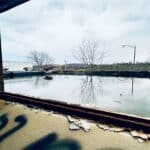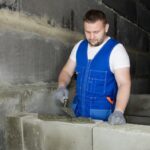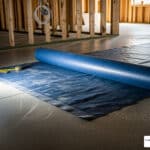Why Your Foundation Hates Maryland’s Weather
If you own a home in Baltimore City, Baltimore County, or Harford County, you know our weather is tough on houses. Heavy rains, summer storms, and winter freezes combine with our dense clay soil to put constant pressure on your foundation. This hydrostatic pressure forces water through tiny cracks, leading to damp basements, mold, and even serious structural damage.
The best foundation drainage system is one designed for your specific home. It often involves a combination of interior and exterior solutions to manage water effectively.
| System Type | Best For | Key Benefit |
|---|---|---|
| Interior Drainage | Active water intrusion | Manages water inside with less disruption |
| Exterior French Drain | New construction or major renovations | Intercepts groundwater before it reaches walls |
| Sump Pump System | High water table areas | Actively removes accumulated water |
| Proper Grading | All properties | Most cost-effective first line of defense |
Ignoring water issues can lead to expensive structural repairs, poor air quality, and a lost living space. The right drainage system stops water before it becomes a major problem. With over 70 years of experience keeping Maryland basements dry, we know that a one-size-fits-all approach doesn’t work. Let’s walk through the options that will actually protect your home.

Decoding the Best Foundation Drainage System for Your Maryland Home
You know something’s not right. That musty smell in the basement, water stains on the walls, or cracks spreading across the concrete aren’t just annoyances; they’re red flags. They warn that water is winning the battle against your foundation, potentially leading to foundation settlement and costly structural repairs.
The good news is you have options. The best foundation drainage system for your home will likely be a combination of exterior and interior systems working together to keep your foundation safe and dry. Let’s break down what works in Maryland’s challenging climate.
Exterior Drainage Systems: The Traditional First Line of Defense
Exterior systems are designed to stop water before it ever touches your foundation walls.
- Footing Drains: Installed deep at the base of your foundation, these are heavy-duty drains that catch groundwater at its source. They are most practical for new construction due to the extensive excavation required for existing homes. They can also become clogged over time, and scientific research has shown potential for soil contaminants to enter local water sources.
- French Drains: These shallower trenches are excellent for managing surface water and shallow groundwater from heavy rains. They channel water away from your foundation but require professional installation and proper maintenance to prevent clogging.
- Curtain Drains: Essentially a French drain placed uphill from your home, a curtain drain intercepts water flowing down a slope before it can saturate the soil around your foundation.
- Proper Grading: Simply ensuring the ground slopes away from your house is a powerful, low-cost way to use gravity to your advantage.
- Gutters and Downspouts: Your roof collects a massive amount of water. Clean gutters with downspout extensions that carry water well away from the foundation are critical.
While proactive, exterior systems on existing homes can be disruptive and expensive due to excavation. You can learn more about exterior excavation waterproofing and what it involves for Maryland homes.
Interior Drainage Systems: The Modern Solution for a Dry Basement
When hydrostatic pressure forces water through your foundation walls, an interior system manages it efficiently.
- Interior Perimeter Drain: Also known as an interior French drain, this system is installed along the inside edge of your basement floor. It collects water that seeps through the walls or floor and channels it to a sump pump. Installation is far less disruptive than exterior excavation and can be done year-round.
- Sump Pump: This is the heart of an interior system. It sits in a pit and actively pumps collected water out and away from your home. Sump pumps are essential for areas with high water tables or heavy rainfall. However, they require electricity, which is why we consider a battery backup for sump pumps to be essential, not optional.
- Drainage Matting & Vapor Barriers: These are installed on the foundation walls before finishing. They create a channel for water to flow down to the drain and block moisture and humidity from entering your basement, preventing mold growth.
Interior systems don’t stop water from reaching your foundation, but they provide powerful, reliable management of any water that gets in. They are often the most practical and effective solution for existing homes with water problems. You can explore our comprehensive basement waterproofing system types, costs, and advantages.
Key Factors for Choosing the Best Foundation Drainage System
There is no single “best” system; the right solution is custom to your home. Here’s what we evaluate:
- Your Symptoms: Are you seeing active leaks, general dampness, or foundation cracks? The signs point to the source of the problem.
- Soil and Slope: Maryland’s heavy clay soil holds water, increasing pressure. Your property’s slope determines where that water naturally flows.
- Foundation Type: Poured concrete, block, and slab foundations have different vulnerabilities that influence the best approach.
- Combining Systems: The most effective strategies layer multiple systems. Good grading and gutters are the first defense, exterior drains intercept groundwater, and interior systems provide a final, failsafe solution.
- Cost vs. Value: A proper drainage system is an investment in protecting your home from far more expensive structural repairs, mold remediation, and loss of property value.
Understanding your home’s unique situation is the key. For a deeper look, check out our guide on water in your foundation: how to protect Maryland homes.
The Oriole Approach: A Dry Foundation for Life
For over 70 years, we’ve been solving foundation and water problems for homeowners in Baltimore City, Baltimore County, and Harford County. We’ve seen it all, and we know that cookie-cutter solutions don’t work here. At Oriole Basement Waterproofing, we don’t just patch symptoms; we find the root cause.
Our holistic assessment examines your home’s entire system: drainage, grading, humidity, and structural integrity. Foundation stability is our priority. Our expertise includes everything from sill plate and floor joist replacement to stabilizing bowing walls with carbon fiber straps. For major repairs, we partner with structural engineers to guarantee a solution built to last. We understand that a healthy crawlspace or basement means a healthier home, so we create dry, sealed environments from the ground up.
The system we recommend will be custom-designed for your home’s unique challenges. We stand behind that work with transferable lifetime warranties on all encapsulation and foundation repairs. It’s our promise to you and the future owner of your home.
Don’t let water compromise your foundation. We’re your local experts, ready to help you find a permanent solution. Schedule your free, no-obligation inspection in Baltimore today and let’s create a dry, healthy, and worry-free foundation together.








